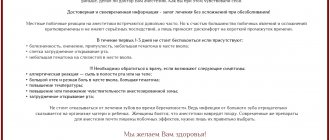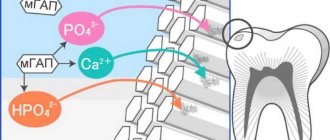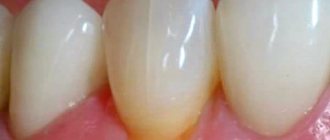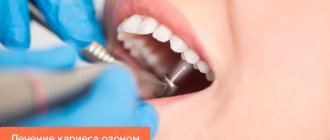What is sedation in dentistry?
Sedation is the suppression of the patient’s consciousness with the help of special means, in which he falls into a state reminiscent of drowsiness, sleep. There are 2 types of this procedure:
- Deep sedation (rarely used in dentistry). The patient falls asleep, is completely unable to follow commands, and often loses the ability to breathe normally. This type of anesthesia is very similar to the use of anesthesia in dentistry.
- Superficial sedation. It implies a minimal impact on consciousness, the patient is “half asleep”, is able to follow the specialist’s instructions, and maintain his breathing. Memories of the treatment itself are not retained in a person’s memory. It is this type of anesthesia in dentistry that we will talk about in this article.
In what cases is sedation contraindicated?
- For children under 3 years old, it is impossible to establish verbal contact and ask about sensations.
- For children with ENT diseases, sedatives will not work and may impair breathing.
- Pregnant women - the effect of the drugs may affect the embryo.
- For patients with epilepsy, nitrous oxide may trigger a seizure.
- If you are allergic to nitrogen or other medications
- After traumatic brain injury, sedatives slightly increase intracranial pressure, which does not harm healthy people, but can worsen the condition after injury.
To find out if you can have sedation, call and consult at the Lad Clinic.
How is sedation different from anesthesia and local anesthesia?
Why is sedation needed in dentistry at all if local anesthesia and anesthesia are available?
If we talk about local anesthesia, then it really does an excellent job of eliminating pain (for 60 - 90 minutes), but tactile sensitivity remains. That is, the patient feels pressure, touch, vibration, which constantly keeps him in tension. And superficial sedation just helps relieve this psychological stress and make the procedure as comfortable as possible.
As for general anesthesia, as we have already found out, its effect is similar to deep sedation. It suppresses the patient's consciousness and protective reflexes (breathing, coughing, gag). This is a rather complex type of anesthesia, which is used in serious surgical operations; it is done for medical reasons when any other type of anesthesia is impossible.
Sedation in dentistry is a whole range of measures that is carried out not only for pain relief, but also to normalize the psycho-emotional state of the patient. Since this procedure cannot completely turn off pain sensitivity, it must be performed in combination with local anesthesia. Thus, dental treatment does not cause anxiety, the patient experiences physical and emotional relaxation.
Methods of sedation in dentistry
With any of the following methods of anesthesia, before the procedure, the patient is asked to clarify information about allergic reactions, previous and concomitant diseases. In addition, examinations are carried out: ECG and blood tests (general, clinical, immunological, infectious).
Before the procedure, the patient must be premedicated: a small dose of a sedative is administered to check. Since sedation does not provide complete pain relief, the dentist will apply a local anesthetic after the medication has taken effect.
Inhalation method
In most cases, a mixture of nitrous oxide and oxygen is used. The patient needs to inhale the air mixture using a mask, which in this case is worn not over the mouth, but over the nose.
| pros | Minuses |
| safe for children under 16 years of age | there should be good nasal breathing. |
| easy recovery after the procedure (as soon as the mask is removed, the effect of the drug stops). | the breathing mask interferes with the dentist’s free activity. |
| the most gentle type of procedure. | There are contraindications: high blood pressure, diseases of the cardiovascular system, first trimester of pregnancy. |
Oral method
Simply put, by taking pills. Most often used: Valium before bedtime and Temazepam before the procedure. This method is most suitable for patients who are terrified of medical intervention. In addition, it is relevant for intolerance to other painkillers. This method is prohibited in case of epilepsy, severe somatic diseases, nasal congestion, pregnancy, sensitivity to drugs, taking alcoholic beverages or drugs the day before.
Intravenous method
Sedative anesthesia in dentistry most often involves the use of intravenous anesthetic drugs: sodium thiopental, benzodiazepines, propofol, and in rare cases, narcotic analgesics. The choice of a particular drug will depend, first of all, on the patient’s individual indicators, the required level of depression of consciousness and other factors. Most often in recent years, propofol has been used for drug sedation in dentistry.
| pros | Minuses |
| nothing interferes with the dentist’s actions. | Contraindicated for children under 16 years of age. a small hematoma in the area where the drug was administered. |
| the effect is achieved very quickly. | a small hematoma in the area where the drug was administered. |
| high degree of depression of consciousness. | recovery after the procedure within an hour. |
Any of these methods leads to drowsiness, relaxation and calm.
Sedation in dentistry is carried out only under the constant supervision of an anesthesiologist.
Types of procedure
| Deep sedation | Superficial sedation |
| Induces the patient into an unconscious state, is prescribed for operations, and is carried out under the supervision of anesthesiologists. | The reaction to stimuli is dulled, but the patient remains conscious. |
Methods
. Depends on the sedatives and route of administration:
- intravenous - by injection, the patient is given sodium thiopental, propofol, ketamine or other drugs that calm the nervous system;
- oral - drugs are taken in the form of tablets or cocktails; Valium, Temazepam and others are used for this purpose;
- inhalation - a mixture of oxygen and nitrogen in a ratio of 7/3 is supplied through a mask, optimally suitable for treating children under sedation.
Contraindications to sedation in dentistry
Despite the widespread use of sedation in dentistry today, there are still contraindications to this procedure:
- Pregnancy (regardless of duration);
- The presence of ethyl alcohol in the blood (intoxication), alcohol dependence (regardless of the stage);
- Chronic state of depression of consciousness, some neurological diseases;
- An allergic reaction to the drugs used (or to their individual components).
Who is an anesthesiologist?
Anesthesiology is a branch of medicine that studies means and methods of providing anesthesia (that is, loss of sensitivity, including pain) for various acute pain syndromes, shock conditions, injuries, and surgical interventions. An anesthesiologist is a specialist who specializes in anesthesiology. This is one of the most erudite and responsible professions of all existing medical specialties. The anesthesiologist has first-class knowledge in all fundamental areas of medicine. He knows how the entire body works as a whole and each of its functional systems, each internal organ, each cell of the body.
As soon as this medical specialty appeared, it immediately became possible to perform surgical interventions without pain, stress and severe, life-threatening complications. The anesthesiologist is equipped with all the knowledge and modern technical capabilities necessary to minimize the risk of fatal complications during the surgeon's operation.
The work of an anesthesiologist is not only about competent and effective pain relief. His work begins even before the operation, with a study of the patient’s medical history and a personal conversation with him. From the patient he learns about his chronic and previous diseases, operations using anesthesia, allergic reactions to medications or food. Taking this information into account, a preliminary analysis of the functioning of the heart, lungs, blood vessels, kidneys and liver is carried out, tests and additional studies are prescribed. All this is necessary for the correct administration of anesthesia during surgery and minimizing the development of possible risks to the patient’s life. Only an anesthesiologist determines the optimal type of anesthesia.
Before an operation or examination, he conducts a calming conversation with the patient. Its meaning is a friendly explanation of the procedure for using anesthesia and neutralizing the fear of surgery. The doctor tells the patient how to properly prepare for the upcoming anesthesia and surgery. It is important that, as a result of such contact, the patient and his family do not feel nervous and are confident in the professionalism of the anesthesiologist.
The use of sedation in pediatric dentistry
It is immediately worth noting that sedation in dentistry for children is especially common in Europe and the USA, where the use of strong painkillers for procedures has long been stopped.
Modern dentistry allows for sedation in two ways:
- Using the oral method. In this case, the child is offered to drink fruit juice with an anesthetic added to it, as a result of which the child calms down, allowing the specialist to carry out all the necessary manipulations. Serious depression of consciousness does not occur in this case - it is more than superficial.
- If the child is understanding, then he is asked to use a special sedation device (it is also used in dentistry for adults), through which the baby will inhale a mixture of drugs, it will relieve fear and eliminate even the strongest anxiety. The use of this method is also not capable of causing any harm to the child or leading to negative consequences.
The sedation method for dental treatment in pediatric dentistry allows you to completely avoid the use of strong anesthetics.
Types of sedation
The InWhite Medical clinic uses two types of sedation based on non-toxic, most modern and safe drugs, which are eliminated from the body within a few minutes after the end of sedation.
- Inhalation sedation. The drug nitrous oxide is used by inhalation through a nasal mask. This method is more often used for children.
- Intravenous sedation. As the name suggests, the sedation drug is administered intravenously - by drip or micro-jet with a special device. The patient is punctured and a peripheral vein is catheterized, after which the device is connected and sedation begins. In our clinic, the drug propofol is used for intravenous sedation.
How much does sedation cost in dentistry?
The price range is quite wide. Firstly, it depends on your location: for example, the cost in Moscow is usually ahead of other cities. Secondly, it is important to choose a good clinic: you shouldn’t chase cheap options - it’s your health after all. Sedation can be dangerous in the hands of unqualified professionals and with outdated equipment. Remember that dental treatment in this case should be carried out only with the presence of an anesthesiologist.
The cost of the procedure in Moscow starts from 10,000 rubles for 1 hour and reaches 15,000 - 25,000 (depending on the characteristics of the patient).
In other cities of our country in the area it ranges from 2,000 to 10,000 rubles per hour.
Prices for dental treatment under sedation
| Service | Price |
| Primary appointment (examination, consultation) with a dentist | 1 500 ₽ |
| Computed tomography of the maxillofacial area (upper and lower jaw) | 3 900 ₽ |
| Computed tomography of the maxillofacial area (one segment) | 1 800 ₽ |
| Orthopantomography (OPTG) | 1 900 ₽ |
| Teleradiography (TRG) | 1 900 ₽ |
| Intravenous anesthesia, sedation (1 hour) | 10 000 ₽ |
| Intravenous anesthesia, sedation (30 min) | 5 000 ₽ |
| Intravenous anesthesia, sedation (5 min) | 833 ₽ |
| Cardiorespiratory monitoring (1 hour) / В03.015.008 | 3 500 ₽ |
| Combined inhalation anesthesia (1 hour) / B01.003.004.008 | 23 000 ₽ |
| Combined inhalation anesthesia (30 min) / B01.003.004.009 | 11 500 ₽ |
Sedation in dentistry: patient reviews
Those who have had dental treatment under sedation once usually want to do it again at their next visit. Why? Because many are afraid of dentists and are ready to avoid not only pain, but also any anxiety associated with visiting one.
In addition, this is convenient if a child is undergoing treatment or tooth extraction, because the baby may simply refuse to open his mouth out of fear.
If you have undergone dental treatment under sedation and want to leave your review, write it in the comments. Many will benefit from your experience and opinion.
Contraindications
There are no obvious contraindications to the use of xenon for pain relief. Despite its high efficiency and safety, the gas is not used for surgical intervention in the respiratory system, as well as for localizing large main vessels. This is due to the fact that the process of supplying gas to the body may be disrupted.
Xenon is not used in people with alcohol dependence, since the drug has a stimulating effect on the neurons of such patients.








